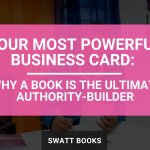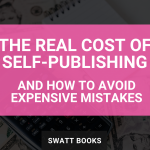Sticking with our theme on the blog this month, let’s talk about another big financial decision you need to make to make your self-published book a success – setting an attractive cover price.
The cover price of your book is one of the key components that determine how much royalty you will earn when you sell a copy – either through a retail channel like Amazon or Waterstones or direct to a reader. Set your cover price too high and you could price yourself out of the market; set it too low and you could damage your profitability. A fine line to walk.
In this post, we’re going to look at the 3 main factors that you need to consider to set an attractive cover price that will ensure both happy readers and a happy bank balance.
Factor 1: Print Cost
The first main aspect that you need to factor into setting an attractive cover price is how much it will cost to get each copy of your book printed. This is a fixed cost at is determined by the physical specifications of your book such as trim size, binding type, page count, and whether the interior pages are printed in full colour or black and white.
If you are publishing your book via a print on demand platforms such as IngramSpark or Amazon KDP, you will be told exactly what the price cost of each copy is when you submit your book listing. Ingram also has a very helpful set of free online calculators to help you experiment to find the optimum specifications for your book before you commit to generating book artwork. The Print & Ship Calculator (https://myaccount.ingramspark.com/Portal/Tools/ShippingCalculator) helps you work out how much it will cost to get books printed and sent to you. The Publishers Compensation Calculator does give you the cost of printing for a book to be sent to a retailer, but is primarily for working out your anticipated royalty – which will come in handy later on…
If you decide to publish your book using a self-distribution model where you get a stock of books printed by a traditional printer and then distribute them yourself, you will need to start getting some quotes from printers. In this scenario, the more books you order, the cheaper the cost of each book but don’t be fooled as this can be a false economy. You will need to take into consideration the cost to store these books while they are waiting to be sold, as well as the cost of shipping them either to a retailer or to the end consumer. A good rule of thumb for calculating individual book production cost in a self-fulfilment publishing model is to take the total cost of your print order, plus any storage costs for 3 months; divide by the number of books you get printed, then add the courier cost of shipping one book to a consumer.
Once you know your book production cost, you need to make sure that the cover price is the same price or higher. If it isn’t, your book will never pay for itself, and you will lose money on every copy sold.
Factor 2: Market Averages
The next factor to consider when setting an attractive cover price is what the market averages for other books similar to yours. The easiest way to do this is to go onto Amazon and browse through the book category that you will be published into. First, look for your closest competitors and make a note of their retail prices. Next, make a note of the retail prices for the top 10 bestselling books in that category. Once you have a list of 10-15 books, highlight the most expensive and cheapest, then calculate the average.
A couple of things to note during this exercise… Be sure to only note down the full RRP and not the price that Amazon is selling it for as Amazon quiet often discounts books. Also, be mindful of the print specifications of the books that you are looking at. Make sure that they are a similar binding type and page count to yours. A 200-page hardback is going to have a dramatically different cover price to a 100-page paperback.
Once done, you will have a maximum, minimum and average price guideline of what readers expect to pay for a similar book to yours. Are they higher than your book production costs? If so, great! You now have a baseline from which to move onto the next factor. If not, then you need to go back to the drawing board and reconsider your print specifications to see where you can trim costs.
Factor 3: Value of You
Have you ever noticed that some books on the same subject have a much higher cover price than others and that readers are willing to pay that higher cover price? That is all down to the perceived value of the author and their unique perspective on that topic. So, the next factor that you need to consider when setting an attractive cover price is the unique value that you bring to your readers.
How much experience do you have on the subject that you are writing about? Do you have a unique perspective or are teaching a brand new approach to a common problem? If the answer is yes, then you can start nudging your cover price slightly above the average (but not above the maximum unless you are supremely convinced that you can back it up!). If you’re relatively new to the field, then you may need to be realistic and potentially lower the price slightly below the average until you gain more experience and credibility (which publishing your book will do!).
What NOT to factor in: Publishing Investment
A common mistake that I see authors try and do when setting their cover price is to try and factor in their initial publishing investment in an attempt to recuperate their costs as quickly as possible. This is a big no-no and will lead you down the path of figures just not adding up.
Trying to work publishing costs such as editing and book design into your book production costs means that you will need to over-inflate your cover price to come up with a figure that at least resembles a profit. The result of this is that you end up pricing your book out of the market to the point that readers will not buy it. Which when you look at it, puts you in a worse situation then if you kept your publication costs separate.
If you want to read up on my solution to this quandary, check out my recent blog on “5 Powerful Ways to Measure Self-Publishing ROI”. It looks at ways that you can account for this initial publication costs and ensure that you do earn that money back… and then some.
Additional Consideration: Wholesale Discount
There is one last consideration that I want to touch on, and that is a Wholesale Discount. It may not have a direct impact on setting an attractive cover price, but it does have an impact on the amount of royalty that you earn as a result of the cover price that you set.
For those of you unfamiliar with the term, a wholesale discount is the discounted price that a retailer (like Amazon or Waterstones) pays for your book for them to sell it to their customer. This is how retailers earn their money.
Some retailers will have a fixed wholesale discount that you have to accept if you want to sell your book in their stores; no ifs ands or buts. If you publish through IngramSpark however, you can determine the wholesale discount that you are willing to offer retailers (within a set range) and the retailer then opts whether to accept your terms and list your book, or not. Again, this is a delicate decision to make – set the percentage too high and you end up giving away most of your profit; set it too low and retailers won’t want to list your book (potentially limiting your books’ availability).
This is where the IngramSpark Publishers Compensation Calculator (https://myaccount.ingramspark.com/Portal/Tools/PubCompCalculator) that I mentioned earlier comes in handy. In it, not only can you see the effect of different cover prices on your projected royalty, but also different wholesale discounts. This resource is completely free and you don’t need to have set up an account with Ingram before you can get access to it, so I strongly recommend that you make good use of it.
So there you have it, the 3 main things that you should consider when setting an attractive cover price for your next self-published book. I hope you have found that useful. If you have, don’t forget to subscribe via the link in the side panel so that you can get more great content like this delivered straight to your inbox.
I want to hear about your experiences with setting the cover price for your book(s) or how you evaluate a books’ cover price when shopping for a new book. Leave your comment below.
Thanks for reading, see you again soon.





